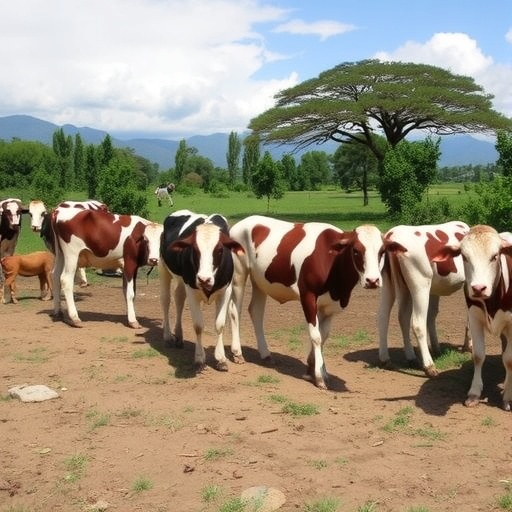The increasing turbulence of climate change is reaching a critical juncture, particularly in the agricultural sector, where its impacts are particularly pronounced. In the central highlands of Ethiopia, dairy cattle production represents a vital component of the local economy and sustenance for countless households. However, recent studies reveal a stark reality: dairy producers are grappling with the escalating challenges and uncertainties brought about by climate variability. Understanding their perceptions and adaptation strategies in light of these challenges is crucial for the sustainability of dairy farming in this region.
The research conducted by Gemechu, Eshetu, and Mummed sheds light on how local dairy producers perceive climate change and their adaptive practices. It indicates that many producers recognize climate change as a real and pressing menace. Changes in precipitation patterns, increased temperatures, and the frequency of extreme weather events have compelled producers to acknowledge that traditional farming practices may no longer suffice. This recognition, however, is the first step towards formulating strategies that will safeguard their livelihoods against climate’s adverse effects.
In interviews carried out with local dairy farmers, the study found that many farmers expressed significant concerns over inconsistent rainfall patterns. These changes not only affect the availability of water for their herds but also disrupt the growth of fodder crops essential for dairy cattle sustenance. Producers noted that prolonged dry spells lead to livestock nutritional deficiencies, which, in turn, affect milk production levels. The consequential economic strain underscores the urgency of addressing climate adaptation strategies, as reduced productivity translates directly to diminished household incomes.
Moreover, the research emphasizes that the perception of climate change varies significantly among producers based on factors such as education, experience, and access to information. Those with higher educational attainment were more likely to recognize the long-term impacts of climate change, while less educated individuals often struggled to relate their observations to broader climatic trends. This knowledge gap presents a challenge in the dissemination of effective adaptation strategies, highlighting the need for targeted educational programs that can bridge this divide.
Furthermore, the adaptation practices employed by dairy farmers are as varied as their perceptions. Some dairy producers have begun experimenting with diversified cropping strategies to enhance fodder availability. They are planting drought-resistant forage crops and utilizing irrigation methods to ensure a steady supply of water for their livestock. However, the lack of resources and technical support often hampers these initiatives, emphasizing a critical need for investment in extension services that can guide farmers through innovative adaptation techniques.
The role of government and local organizations becomes increasingly significant as these adaptation strategies unfold. There is a clear imperative for policymakers to create an enabling environment where sustainable agriculture can flourish. This includes investments in infrastructure that supports water management during drought periods and the establishment of cooperatives that can help dairy farmers access markets and resources collectively. Without coherent policy frameworks and support systems, many dairy producers may struggle to transition to more resilient farming practices amid changing climate conditions.
Another significant finding from the research highlights the emotional toll that climate change has taken on dairy farmers. Many reported feelings of anxiety and uncertainty about the future of their farms and livelihoods. This psychological impact is often overlooked but plays a crucial role in how producers approach adaptation. Implementing programs that provide emotional and psychological support alongside practical agricultural training may enhance resilience and improve the overall well-being of dairy farming communities.
The interconnectedness of climate change, agricultural sustainability, and food security cannot be overstated. As dairy cattle production becomes increasingly jeopardized by climatic shifts, the implications extend far beyond individual farmers. The ripple effect can impact local economies, food availability, and even national food security. Therefore, stakeholders at all levels must recognize the urgency of this issue and mobilize resources to bolster the resilience of dairy producers in the face of climate change.
In conclusion, the findings of Gemechu, Eshetu, and Mummed’s study paint a complex picture of dairy cattle producers’ realities amidst climate change. While there are notable initiatives and adaptive strategies emerging, they are often hindered by systemic challenges, including lack of knowledge, funding, and psychological stress. The road ahead demands a multifaceted approach that integrates agricultural innovation, emotional support, and policy reform to ensure that dairy farming in the central highlands of Ethiopia can withstand the test of climate change.
The study serves as a call to action for researchers, policymakers, and the farming community to collaborate in sustainably navigating these tumultuous environmental changes. By embracing adaptive measures and fostering a culture of resilience among dairy producers, it is possible not only to safeguard livelihoods but also to contribute to a more stable and sustainable future in the region.
Subject of Research: Climate Change Adaptation in Dairy Farming
Article Title: Dairy cattle producers’ perception of climate change and variability and adaptation strategies in the central highlands of Ethiopia.
Article References:
Gemechu, T., Eshetu, M., Mummed, Y.Y. et al. Dairy cattle producers’ perception of climate change and variability and adaptation strategies in the central highlands of Ethiopia.
Discov Sustain 6, 895 (2025). https://doi.org/10.1007/s43621-025-01871-w
Image Credits: AI Generated
DOI: 10.1007/s43621-025-01871-w
Keywords: Climate Change, Dairy Farming, Adaptation Strategies, Ethiopia, Food Security.




